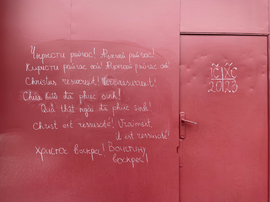The Paschal greeting, also known as the Easter Acclamation or Easter Day Greeting, is an Easter custom among many Christian churches, including Eastern Orthodox, Oriental Orthodox, Roman Catholic, Anglican, Lutheran,[1] Methodist,[2] Presbyterian,[3] and Congregational.[4]


One offers the greeting "Christ is risen!" and the response is "Indeed He is Risen!" or "He is risen indeed!" with many variants in English and other languages (compare Matthew 27:64, Matthew 28:6–7, Mark 16:6, Luke 24:6, Luke 24:34).[5][6]
Theories on origin
editCredits for the origin of the greeting vary. However, the phrase "Christ is risen" is likely a shortened piece from Matthew 28:5-6, "The angel said to the women, “Do not be afraid, for I know that you are looking for Jesus, who was crucified. He is not here; he has risen, just as he said. Come and see the place where he lay."[7]
There are two competing theories for the source of the response, "He is risen indeed." The first follows the tradition, not mentioned in the Bible, of Mary Magdalene bringing an egg to Emperor Tiberius. She then greeted the emperor with the words, "Christ is risen."[8] Others believe that the response comes from the Gospel of Luke 24:33-34 "There they found the Eleven and those with them, assembled together and saying, 'It is true! The Lord has risen and has appeared to Simon.'"[9] Regardless of the initial source, the phrase has become part of the Christian tradition. The greeting is used by many to celebrate the belief in the resurrection of Jesus Christ on Easter morning.[10]
Examples
editIt is used among members of some Christian denominations when meeting one another during Eastertide; some even text or answer their phones with the phrase.
Eastern Orthodox
editThe greeting and reply are:
Christ is Risen! – Truly He is Risen!
- In the original language, Greek: Χριστός ἀνέστη! – Ἀληθῶς ἀνέστη!, romanized: Khristós anésti! – Alethós anésti![11]
- In the most widely-used language, Church Slavonic: Хрїсто́съ воскре́се! – Вои́стинꙋ воскре́се!, romanized: Khristósŭ voskrése! – Voístinu voskrése![12]
A list in 57 languages is found at the website of the Orthodox Church in America.[13]
In some cultures, such as in Russia and Serbia, it is also customary to exchange a triple kiss of peace on alternating cheeks after the greeting.[14]
Catholic
editIn the Latin Church, the traditional greeting on Easter morning and throughout the Easter Octave is: Christus surréxit! - Surréxit vere, allelúja (“Christ is risen!” - “He is risen indeed, Alleluia!”). This ancient phrase is similar to the Greek one, and echoes the greeting of the angel to Mary Magdalene and Mary, the mother of James, as they arrived at the sepulchre to anoint the body of Jesus: "He is not here; for he has risen, as he said" (Matthew 28:6). [5]
References
edit- ^ Carson, Emily (23 Apr 2022). "'He is risen' is a greeting for the ages". Rochester Post Bulletin. Post Bulletin and Forum Communications Company. Retrieved 9 April 2023.
- ^ "Easter Day Greeting". United Methodist Church Discipleship Ministries. United Methodist Church. Retrieved 9 April 2023.
- ^ Hardwick, Rev. Dr. Chip. "Worship Resource 2020" (PDF). psusa.org. Presbyterian Church (USA). Retrieved 9 April 2023.
- ^ "The Art and Practice of the Congregational Church". naccc.org. The National Association of Congregational Christian Churches. 3 March 2021. Retrieved 9 April 2023.
- ^ a b Kovacs, Judith L. (2005). 1 Corinthians: Interpreted by Early Christian Commentators. Wm. B. Eerdmans Publishing. p. 10. ISBN 9780802825773.
- ^ W.H. Withrow, M.A., D.D., F.R.S.C. (1904). Methodist Magazine and Review. 59: 550.
{{cite journal}}: Missing or empty|title=(help)CS1 maint: multiple names: authors list (link) - ^ Matthew 28
- ^ Filz, Gretchen. "The Story of Mary Magdalene and the First Easter Egg". catholiccompany.com. The Catholic Company. Retrieved 9 April 2023.
- ^ Luke 24:33–34
- ^ Riggleman, Heather. "'He is Risen Indeed' - Meaning and Easter Origin". crosswalk.com. Salem Media Group. Retrieved 9 April 2023.
- ^ "ΠΑΣΧΑ". ΠΕΝΤΗΚΟΣΤΑΡΙΟΝ. The Greek Orthodox Archdiocese of America. Retrieved 2020-04-18.
- ^ "Пасхальная Заутреня" (PDF). Цветная Триодь. Моско́вскій патріарха́тъ. Retrieved 2020-04-18.
- ^ "Paschal Greetings from Around the World". Orthodoxy. Orthodox Church in America. 2020. Retrieved 2020-05-03.
- ^ "The Origin and Meaning of the Paschal Greeting". Feasts. The Cathedral Church of St. John the Baptist. Archived from the original on 2013-04-03. Retrieved 2020-07-30.
External links
edit- The Origin and Meaning of the Paschal Greeting, Russian Orthodox Cathedral of St. John the Baptist, Washington, DC.